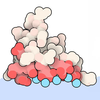+ Open data
Open data
- Basic information
Basic information
| Entry | Database: PDB / ID: 1ba8 | ||||||
|---|---|---|---|---|---|---|---|
| Title | THROMBIN INHIBITOR WITH A RIGID TRIPEPTIDYL ALDEHYDES | ||||||
 Components Components |
| ||||||
 Keywords Keywords | HYDROLASE/HYDROLASE INHIBITOR / HYDROLASE-HYDROLASE INHIBITOR COMPLEX | ||||||
| Function / homology |  Function and homology information Function and homology informationnegative regulation of serine-type peptidase activity / cytolysis by host of symbiont cells / thrombospondin receptor activity / Defective factor XII causes hereditary angioedema / thrombin / thrombin-activated receptor signaling pathway / negative regulation of astrocyte differentiation / regulation of blood coagulation / positive regulation of phospholipase C-activating G protein-coupled receptor signaling pathway / neutrophil-mediated killing of gram-negative bacterium ...negative regulation of serine-type peptidase activity / cytolysis by host of symbiont cells / thrombospondin receptor activity / Defective factor XII causes hereditary angioedema / thrombin / thrombin-activated receptor signaling pathway / negative regulation of astrocyte differentiation / regulation of blood coagulation / positive regulation of phospholipase C-activating G protein-coupled receptor signaling pathway / neutrophil-mediated killing of gram-negative bacterium / Defective F8 cleavage by thrombin / Platelet Aggregation (Plug Formation) / ligand-gated ion channel signaling pathway / positive regulation of collagen biosynthetic process / negative regulation of platelet activation / negative regulation of blood coagulation / positive regulation of blood coagulation / negative regulation of fibrinolysis / regulation of cytosolic calcium ion concentration / Transport of gamma-carboxylated protein precursors from the endoplasmic reticulum to the Golgi apparatus / Gamma-carboxylation of protein precursors / Common Pathway of Fibrin Clot Formation / Removal of aminoterminal propeptides from gamma-carboxylated proteins / fibrinolysis / Intrinsic Pathway of Fibrin Clot Formation / negative regulation of proteolysis / negative regulation of cytokine production involved in inflammatory response / Peptide ligand-binding receptors / Regulation of Complement cascade / positive regulation of release of sequestered calcium ion into cytosol / acute-phase response / Cell surface interactions at the vascular wall / positive regulation of receptor signaling pathway via JAK-STAT / growth factor activity / serine-type endopeptidase inhibitor activity / lipopolysaccharide binding / positive regulation of insulin secretion / platelet activation / response to wounding / positive regulation of protein localization to nucleus / Golgi lumen / Regulation of Insulin-like Growth Factor (IGF) transport and uptake by Insulin-like Growth Factor Binding Proteins (IGFBPs) / positive regulation of reactive oxygen species metabolic process / blood coagulation / antimicrobial humoral immune response mediated by antimicrobial peptide / regulation of cell shape / heparin binding / : / Thrombin signalling through proteinase activated receptors (PARs) / toxin activity / positive regulation of cell growth / blood microparticle / G alpha (q) signalling events / cell surface receptor signaling pathway / positive regulation of phosphatidylinositol 3-kinase/protein kinase B signal transduction / receptor ligand activity / endoplasmic reticulum lumen / signaling receptor binding / serine-type endopeptidase activity / positive regulation of cell population proliferation / calcium ion binding / proteolysis / extracellular space / extracellular exosome / extracellular region / plasma membrane Similarity search - Function | ||||||
| Biological species |  Hirudo medicinalis (medicinal leech) Hirudo medicinalis (medicinal leech) Homo sapiens (human) Homo sapiens (human) | ||||||
| Method |  X-RAY DIFFRACTION / X-RAY DIFFRACTION /  MOLECULAR REPLACEMENT / Resolution: 1.8 Å MOLECULAR REPLACEMENT / Resolution: 1.8 Å | ||||||
 Authors Authors | Krishnan, R. / Zhang, E. / Hakansson, K. / Arni, R.K. / Tulinsky, A. / Lim-Wilby, M.S.L. / Levy, O.E. / Semple, J.E. / Brunck, T.K. | ||||||
 Citation Citation |  Journal: Biochemistry / Year: 1998 Journal: Biochemistry / Year: 1998Title: Highly selective mechanism-based thrombin inhibitors: structures of thrombin and trypsin inhibited with rigid peptidyl aldehydes. Authors: Krishnan, R. / Zhang, E. / Hakansson, K. / Arni, R.K. / Tulinsky, A. / Lim-Wilby, M.S. / Levy, O.E. / Semple, J.E. / Brunck, T.K. | ||||||
| History |
|
- Structure visualization
Structure visualization
| Structure viewer | Molecule:  Molmil Molmil Jmol/JSmol Jmol/JSmol |
|---|
- Downloads & links
Downloads & links
- Download
Download
| PDBx/mmCIF format |  1ba8.cif.gz 1ba8.cif.gz | 80.6 KB | Display |  PDBx/mmCIF format PDBx/mmCIF format |
|---|---|---|---|---|
| PDB format |  pdb1ba8.ent.gz pdb1ba8.ent.gz | 57.2 KB | Display |  PDB format PDB format |
| PDBx/mmJSON format |  1ba8.json.gz 1ba8.json.gz | Tree view |  PDBx/mmJSON format PDBx/mmJSON format | |
| Others |  Other downloads Other downloads |
-Validation report
| Summary document |  1ba8_validation.pdf.gz 1ba8_validation.pdf.gz | 478.4 KB | Display |  wwPDB validaton report wwPDB validaton report |
|---|---|---|---|---|
| Full document |  1ba8_full_validation.pdf.gz 1ba8_full_validation.pdf.gz | 500 KB | Display | |
| Data in XML |  1ba8_validation.xml.gz 1ba8_validation.xml.gz | 11.5 KB | Display | |
| Data in CIF |  1ba8_validation.cif.gz 1ba8_validation.cif.gz | 16.8 KB | Display | |
| Arichive directory |  https://data.pdbj.org/pub/pdb/validation_reports/ba/1ba8 https://data.pdbj.org/pub/pdb/validation_reports/ba/1ba8 ftp://data.pdbj.org/pub/pdb/validation_reports/ba/1ba8 ftp://data.pdbj.org/pub/pdb/validation_reports/ba/1ba8 | HTTPS FTP |
-Related structure data
| Related structure data | 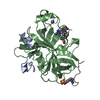 1bb0C 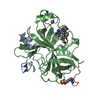 1ca8C  1yyyC 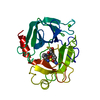 1zzzC  1tmbS S: Starting model for refinement C: citing same article ( |
|---|---|
| Similar structure data |
- Links
Links
- Assembly
Assembly
| Deposited unit | 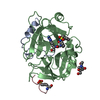
| ||||||||
|---|---|---|---|---|---|---|---|---|---|
| 1 |
| ||||||||
| Unit cell |
|
- Components
Components
-Protein/peptide , 2 types, 2 molecules AC
| #1: Protein/peptide | Mass: 4096.534 Da / Num. of mol.: 1 / Source method: isolated from a natural source / Source: (natural)  Homo sapiens (human) / Tissue: BLOOD / References: UniProt: P00734, thrombin Homo sapiens (human) / Tissue: BLOOD / References: UniProt: P00734, thrombin |
|---|---|
| #3: Protein/peptide | Mass: 1561.577 Da / Num. of mol.: 1 Source method: isolated from a genetically manipulated source Source: (gene. exp.)  Hirudo medicinalis (medicinal leech) / References: UniProt: P01050*PLUS Hirudo medicinalis (medicinal leech) / References: UniProt: P01050*PLUS |
-Protein / Sugars , 2 types, 2 molecules B

| #2: Protein | Mass: 29780.219 Da / Num. of mol.: 1 / Source method: isolated from a natural source / Source: (natural)  Homo sapiens (human) / Tissue: BLOOD / References: UniProt: P00734, thrombin Homo sapiens (human) / Tissue: BLOOD / References: UniProt: P00734, thrombin |
|---|---|
| #5: Sugar | ChemComp-NAG / |
-Non-polymers , 2 types, 159 molecules 


| #4: Chemical | ChemComp-0IT / |
|---|---|
| #6: Water | ChemComp-HOH / |
-Details
| Has protein modification | Y |
|---|---|
| Nonpolymer details | THE ACTIVE SITE SER 195 IS CLOSE TO THE CARBONYL CARBON (C2) OF THE ALDEHYDE GROUP OF THE INHIBITOR ...THE ACTIVE SITE SER 195 IS CLOSE TO THE CARBONYL CARBON (C2) OF THE ALDEHYDE GROUP OF THE INHIBITOR BUT DOES NOT FORM A TETRAHEDRA |
-Experimental details
-Experiment
| Experiment | Method:  X-RAY DIFFRACTION / Number of used crystals: 1 X-RAY DIFFRACTION / Number of used crystals: 1 |
|---|
- Sample preparation
Sample preparation
| Crystal | Density Matthews: 2.5 Å3/Da / Density % sol: 51 % | ||||||||||||||||||||||||
|---|---|---|---|---|---|---|---|---|---|---|---|---|---|---|---|---|---|---|---|---|---|---|---|---|---|
| Crystal grow | pH: 7.5 / Details: pH 7.5 | ||||||||||||||||||||||||
| Crystal | *PLUS | ||||||||||||||||||||||||
| Crystal grow | *PLUS Method: vapor diffusion, hanging drop / Details: used to seeding | ||||||||||||||||||||||||
| Components of the solutions | *PLUS
|
-Data collection
| Diffraction | Mean temperature: 300 K |
|---|---|
| Diffraction source | Wavelength: 1.5418 |
| Detector | Type: RIGAKU / Detector: IMAGE PLATE / Date: Aug 1, 1995 |
| Radiation | Monochromator: NI FILTER / Monochromatic (M) / Laue (L): M / Scattering type: x-ray |
| Radiation wavelength | Wavelength: 1.5418 Å / Relative weight: 1 |
| Reflection | Resolution: 1.8→15 Å / Num. obs: 22257 / % possible obs: 61 % / Observed criterion σ(I): 2.5 / Redundancy: 2.5 % / Rmerge(I) obs: 0.045 / Rsym value: 0.12 / Net I/σ(I): 14 |
| Reflection shell | Resolution: 1.8→2 Å / Redundancy: 2 % / Rmerge(I) obs: 0.07 / Mean I/σ(I) obs: 2.5 / Rsym value: 0.25 / % possible all: 38 |
| Reflection | *PLUS Redundancy: 1.8 % / Num. measured all: 40769 / Rmerge(I) obs: 0.078 |
| Reflection shell | *PLUS % possible obs: 38 % / Rmerge(I) obs: 0.184 |
- Processing
Processing
| Software |
| ||||||||||||||||||||||||||||||||||||||||||||||||||||||||||||||||||||||||||||||||||||
|---|---|---|---|---|---|---|---|---|---|---|---|---|---|---|---|---|---|---|---|---|---|---|---|---|---|---|---|---|---|---|---|---|---|---|---|---|---|---|---|---|---|---|---|---|---|---|---|---|---|---|---|---|---|---|---|---|---|---|---|---|---|---|---|---|---|---|---|---|---|---|---|---|---|---|---|---|---|---|---|---|---|---|---|---|---|
| Refinement | Method to determine structure:  MOLECULAR REPLACEMENT MOLECULAR REPLACEMENTStarting model: PDB ENTRY 1TMB Resolution: 1.8→7 Å / Cross valid method: THROUGHOUT / σ(F): 4 Details: RESIDUES 148 - 149 IN THE B CHAIN WERE DISORDERED AND ARE NOT INCLUDED IN THE COORDINATES.
| ||||||||||||||||||||||||||||||||||||||||||||||||||||||||||||||||||||||||||||||||||||
| Displacement parameters | Biso mean: 26.5 Å2 | ||||||||||||||||||||||||||||||||||||||||||||||||||||||||||||||||||||||||||||||||||||
| Refine analyze | Luzzati coordinate error obs: 0.2 Å / Luzzati d res low obs: 7 Å | ||||||||||||||||||||||||||||||||||||||||||||||||||||||||||||||||||||||||||||||||||||
| Refinement step | Cycle: LAST / Resolution: 1.8→7 Å
| ||||||||||||||||||||||||||||||||||||||||||||||||||||||||||||||||||||||||||||||||||||
| Refine LS restraints |
| ||||||||||||||||||||||||||||||||||||||||||||||||||||||||||||||||||||||||||||||||||||
| Software | *PLUS Name: PROLSQ / Classification: refinement | ||||||||||||||||||||||||||||||||||||||||||||||||||||||||||||||||||||||||||||||||||||
| Refinement | *PLUS Rfactor obs: 0.152 | ||||||||||||||||||||||||||||||||||||||||||||||||||||||||||||||||||||||||||||||||||||
| Solvent computation | *PLUS | ||||||||||||||||||||||||||||||||||||||||||||||||||||||||||||||||||||||||||||||||||||
| Displacement parameters | *PLUS |
 Movie
Movie Controller
Controller



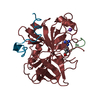
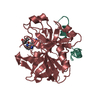
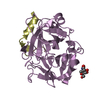

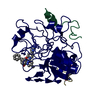
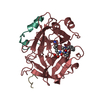

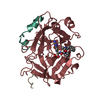
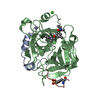
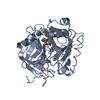
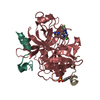
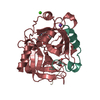

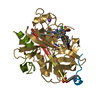
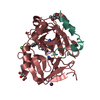
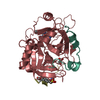


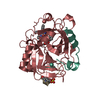

 PDBj
PDBj


